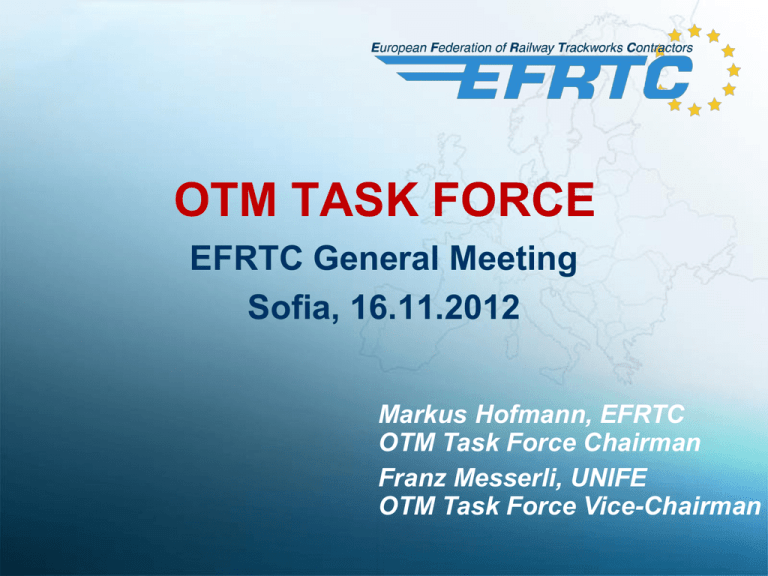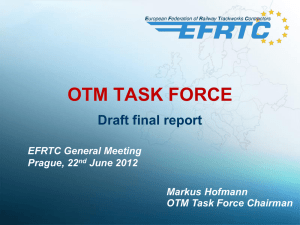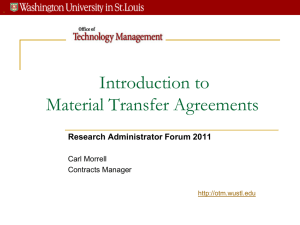the OTM presentation
advertisement

OTM TASK FORCE EFRTC General Meeting Sofia, 16.11.2012 Markus Hofmann, EFRTC OTM Task Force Chairman Franz Messerli, UNIFE OTM Task Force Vice-Chairman Current situation • Increasing costs of authorisation – Due to the increased demand of the scope of the authorisation requiring more resources and time – Cost varies from few thousands of Euro for simple type authorisation up to € 200 k€ and even up to 20 % of manufacturing costs in some countries • Excessive deadlines for placing OTMs into service – Deadlines varies from about 3 to 6 months for simple type authorisation up to 2 years and even more • No Cross-acceptance – With some exceptions no cross-acceptance for the same type of the machines, often with full duplication of authorisation resulting in demand for changing the components EFRTC GM, Sofia 16.11.2012, OTM Task Force Task Force objectives • To reduce costs of the authorisation • To shorten the time for placing into the service • To facilitate cross-acceptance From today: “national homologation” NL D To future; “European authorisation” F I D CH A NL I notified national requirements (B/C) CH TSI and notified national requirements (A) EFRTC GM, Sofia 16.11.2012, OTM Task Force Basic requirements • OTM are designed and manufactured for working on the track and not to operate so they should never be considered for the scope of the limited movements on the track as any category of rolling stock • TSI compliance should be at no cost increase but simplifications, cost and time reduction • Transparency of authorisation and clarity of assessment criteria in all EC regulatory framework and national reference documents • Type certification against TSI by manufacturer to be Europe-wide acknowledged – re-checking strictly limited • Specific national requirements to be declared and known in advance in national reference documents to be accepted by ERA • Acceptance of the EN standards relevant to OTM in national rules is to be reviewed with the aim for identifying potential for their harmonisation with TSIs and as basis for cross-acceptance EFRTC GM, Sofia 16.11.2012, OTM Task Force Current trends • Two fundamentally different trends: – Either the European position will become stronger in the long term view (TSI will become mandatory for OTM in the future) – or OTMs remain on the long-term view in the field of national approval processes • There are players which act with pressure for both strategies but national approval processes prevail • OTM Task Force strategy is in line with its objectives i.e. European harmonisation as much as possible but respecting justified national specific conditions i.e. – To assure that the OTM requirements will be considered in the current revisions of TSIs even if they will be not mandatory for TSI – To assure that the relevant EN standards to OTM (in particular EN 14 033) are harmonised with the relevant TSIs (in particular TSI Loc&Pas) EFRTC GM, Sofia 16.11.2012, OTM Task Force OTM TF proposed strategy • TSI RST are still voluntary for OTMs – no problem for the near future but as applicant has a choice between TSI or national authorisation there will be always two types of OTMs – OTM-1 with full authorisation in accordance with TSIs – OTM-2 applying national authorisation using EN standards • It is therefore important to ensure that − Relevant EN standards covers the essential requirements of the relevant TSIs − EN 14033-x are harmonised standards for the TSI RST as well as the Machinery Directive − for OTM-1 the mutual recognition is granted − for OTM-2 the national approval is based on harmonised standards with TSI and multi-national approvals are performed only for specific national requirements (open points) agreed for cross acceptance procedures EFRTC GM, Sofia 16.11.2012, OTM Task Force OTM definition/scope in TSI • Mobile railway infrastructure construction and maintenance equipment or on-track machines (OTM) are vehicles specially designed for construction and maintenance of the track and infrastructure • OTMs are used in different modes: working mode, transport mode as self-propelling vehicle and/or as a hauled vehicle. • OTM are only classified as a separate OTM category in TSI. They shall not fall into any other category or unit of rolling stock as it stands in current version of TSI • No road/rail-vehicles according EN 15746-x • No gauge-changing vehicles • Infrastructure inspection vehicles and switch transportation wagon are included in the category OTM with some specific conditions EFRTC GM, Sofia 16.11.2012, OTM Task Force OTM Task Force performed • Review of all articles of TSI CR LOC&PAS with regard to their relevance to OTM • Identification of articles which are relevant to the authorisation of OTM subject the clause 7 enter into force (In case TSI will become mandatory for OTMs too) • Comparison of coverage of OTM authorisation as defined by EN 14033 with relevant clauses of TSI • Review of the harmonization of EN 14033 with TSI as stipulated in Annex ZA of the standard • Identification of discrepancies between TSI and EN 14033 • Identification of the potential critical items for OTM authorisation and cross-acceptance in TSIs (LOC&PAS, CCS, SRT and NOISE) • Final report with Annexes presenting detailed analyses to the above items completed EFRTC GM, Sofia 16.11.2012, OTM Task Force OTM Task Force outcome • First version of the draft final report - the list of the TSI requirements to be considered by OTM completed in May 2012 • List reviewed by OTM Task Force with a view to identifying items – To be considered in the current revision of TSI Loc&pas – To be taken into account in the EN 14 0033 when harmonising it with relevant TSIs • The output reviewed by OTM Task Force core group to produce clear classification of items – – – – Where the request for the TSI change shall be written in ERA format To be reviewed by CEN TC 256/WG 5 in the current revision of EN 14 033-1 To be considered for the inclusion in the Annex C of TSI Loc&Pas To be declared not applicable to OTM • OTM Task Force request for change of draft TSI text (supported by TC 256/SC1 WG5) agreed for the submission to UNIFE and ERA • Order of the standards and their relevance to OTM • Identification of the most costly requirements EFRTC GM, Sofia 16.11.2012, OTM Task Force Major critical items • OTM are not classified in current TSI as a special category and they can fall under an other category and/or unit of rolling stock. This may impose the additional requirements on OTM authorisation which are either excessive or not at all relevant to OTM • Besides all currently open points in TSI such as e.g. specification of events to be recorded, fire protection in tunnels, etc. the most critical items for OTM are: – Clear definition of the scope of the dynamic running test – Scope of the specifications for braking systems and tests in TSI and EN 14 033-1 – Composite brake blocks – noise issues – Signalling systems and ETCS requirements – Structural requirements for bogie frames and wheels – Event recording devices • Link to the Task Force request for the change of the draft – Annex 4_UNIFE-EFRTC OTM Task Force request for change of TSI Loc&Pas to ERA_SB_MJ_IK_final.docx EFRTC GM, Sofia 16.11.2012, OTM Task Force Next steps • To start the dialog with NSA of major countries at the national level (e.g. German contractors and manufacturers have already met EBA and received its support for proposed approach to ERA) • The same approach to be initiated in France, UK, Italy, etc. to assure that TSI requirements on OTM and harmonised EN 14 033 are transposed into the national regulations as the first step for mutual cross- acceptance of authorisation processes • To continue informal contacts with ERA aiming at enhancing the authorisation process towards European cross-acceptance of OTM EFRTC GM, Sofia 16.11.2012, OTM Task Force OTM TASK FORCE Thank you for your attention ! ! !







